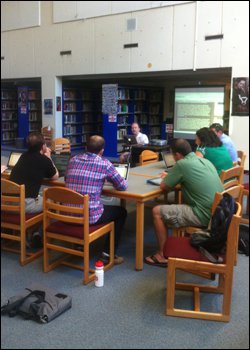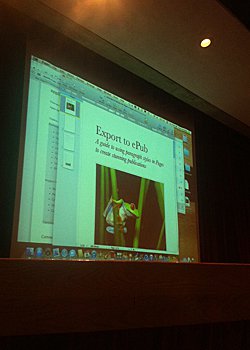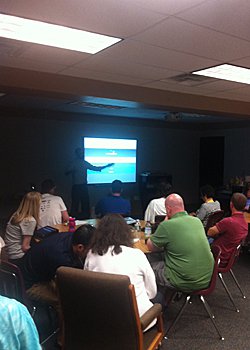Creating ePubs: A Model for Multi-District Collaboration
Teachers met in Massachusetts to produce an ePub, but left with a new model for collaboration.
Your content has been saved!
Go to My Saved Content.There is a growing buzz in the education community about the possibility of moving away from traditional textbooks. While the objective seems clear as to why we should be making this move, the question of how to transition this great shift remains. Educators creating their own digital resource for the classroom possesses great value, but at this point there are still more questions than answers. A group of Massachusetts educators got together and tried to answer some of the lingering questions.

Two weeks ago Burlington Public Schools hosted the first Massachusetts Digital Publication Collaborative. For four days attendees from all over MA came to Burlington High School. The topic: creating a digital publication that students could use with an iPad. It had never been done in this fashion, at least to my knowledge. While the takeaway seemed to be a tangible product every teacher could immediately use in his or her classroom, there was something much bigger happening. Lines of communication and collaboration were opening among districts. Teachers were connecting, learning and creating transparently. In the next four days we, as a collection of content area teachers, instructional technologists, principals, superintendents, and the MA commissioner of education, Mitchell Chester, joined together to create digital publications for our curriculum and build a community of learners focused on improving and evolving their classroom practice.
Multi-District Collaboration
This initiative started with collaboration between Burlington Public Schools administration, educational technology, IT staff and Apple. We designed a website that included a registration form on the front page and blasted out the event details along with the website to all middle and high school principals and superintendents. After a week of being live, the registration tally hovered around 80 participants from roughly ten districts in Massachusetts.
Teachers' Voice
The first day began with teachers, about to embark on their first week of summer vacation, coming together to share ideas about curriculum and best practices. This initiative was not about technology, but more about creating engaging curriculum, which in turn yields dynamic learning environments. The devices of technology simply supported our collaboration and allowed the process to live on beyond the four days in June and reach a broader audience.
Goals
The first day of the MA digital collaborative was designed to present an overview of our goals as a multi-district collaborative. Superintendents Dr. Eric Conti, Burlington Public Schools, Dr. Marinel D. McGrath, Andover Public Schools, and Dr. Maureen LaCroix, Bedford public schools stressed the need for districts in MA to open up district lines and share what is happening in their schools and classrooms. Conti added that we have the tools and devices in our hand to make these collaborations a reality.
Copyright Concerns
The focus shifted momentarily towards copyright and fair use guidelines in education as well as an overview of Creative Commons licensing. Burlington Public Schools Director of Technology, Dennis Villano, and myself led this conversation. We stressed the importance of citing work, but at the same time promoted the idea of collecting information beyond text. This is where we presented creative commons. At the moment, the majority of the audience had not heard about Creative Commons. While this overview was brief, it was imperative that we cover and cite our tracks. Creative Commons and citation of copyrighted material became a daily talking point as we moved forward.

Creating an ePub
Paul Facteau from Apple conducted the next session. Paul detailed the collaborative collection process via a wiki and presented a overview of pages. Paul detailed the workflow we would be using for creating an ePub over the next few days. He also stressed that we should focus on collecting and gathering our curriculum rather than racing towards a finished product. In short, the next four days would be more about the process than the finished product.
Content Collaboration
After the opening keynotes, the audience was released and began to coordinate in cohorts based on content area and discipline level. The organizers of the event took a deep breath and proceeded to watch the day unfold. We posted a Google form on the website to glean feedback about the day. While most of the responses were positive, we had a few that sought more direction. Creative Commons and the wiki were two other common trouble spots that were voiced after day one. We began the next day covering all of the trouble spots we heard about on day one. We also made sure our instructional technology team hovered around each cohort for help with any problems that may impede the process.
ePub Showcase
The next few days ran smoothly. On Wednesday the Massachusetts Commissioner of Education, Mitchell Chester, came to observe our progress. Teachers from Bedford High School presented a physics lesson using the iPad, and math teachers from Burlington High School showcased the first few chapters of their applied math ePub. The commissioner also observed a demonstration of Socrative, a student response, assessment tool for the classroom, led by Ben Berte.
Reflections
Overall, the week was a success. While many teachers did not leave with a finished book, they left with something greater. They left having experienced a new process for curriculum design. Teachers that never worked together before because of district isolation were now sharing their expertise. As I observed many of the content area cohorts, I heard and witnessed collaborative learning amongst professionals. Curriculum binders were open and visible to others. Best practices were flying around the room in various forms. Teachers, who normally worked alone, because of district lines or departmental isolation, were now working in communion with one another.

Everyone involved in this event walked away better than when we entered Monday morning. While the common objective of all participants was to create an ePub, participants walked away with much more. They walked away with new colleagues that they could connect and share with in the future. They walked away with fresh ideas about their discipline. Everyone involved walked away as an ambassador for shared and transparent learning.
And this led to my final takeaway. These four days, while fixed on a common objective, struck a bigger chord with me. The more education evolves, the more it stays true to its roots. Technology does not dramatically change education; it allows us to open it up in different directions. Teachers will always teach, and dynamic pedagogy will always drive the education vehicle forward. The education field always need experts in specified content areas that are able to adapt and innovate their practices from year to year. What technology allows us to do is create broader communities from which we can learn and share.